
- •Unit 17 Barrier-Free Architecture & Universal Design
- •Installation of wheelchair-ready restrooms
- •Unit 18 Bolshoi Theatre Restoration
- •Circle in the list the words and expressions you know. Write down their translation in the table and calculate the percentage of your lexical competence.
- •Circle in the list the words and expressions you know. Write down their translation in the table and calculate the percentage of your lexical competence.
- •Unit 20 Architecture and Creativity
- •Circle in the list the words and expressions you know. Write down their translation in the table and calculate the percentage of your lexical competence.
- •Inside a Salk Institute's study
Unit 17 Barrier-Free Architecture & Universal Design
1 Introduction2 interface
1.1 Read the text title and hypothesize what the text is about. Write down your hypothesis.
…………………………………………………………………………………………………………………………………………………………………………………………………………………………………………………………………………………………………………………………………………………………………………………………………………………………………………
What do you know concerning this issue? List your ideas in the table left column “I know”.
-
I know that…
I have learnt that…
If you know answers to these questions write them down in the space given after each question.
-
1
What does the term "Universal design" mean?
2
Why is there a growing interest in universal design?
3
What are main obstacles for wheelchair users?
4
What Universal Design features can benefit many types of users?
5
What does barrier-free building modification consists of?
6
Where is barrier-free town situated?
7
What safety features are provided for blind people in the City of Takayama?
Circle in the list the words and expressions you know. Write down their translation in the table and calculate the percentage of your lexical competence.
-
1
disability
a curb cut
2
barrier-free
a sidewalk ramp
3
life expectancy
social inclusion
4
survival rate
free accessibility
5
a wheelchair user
an estate home
6
blind people
a lowered threshold
7
to endanger
slip resistant
8
an upsurge
Braille markings
U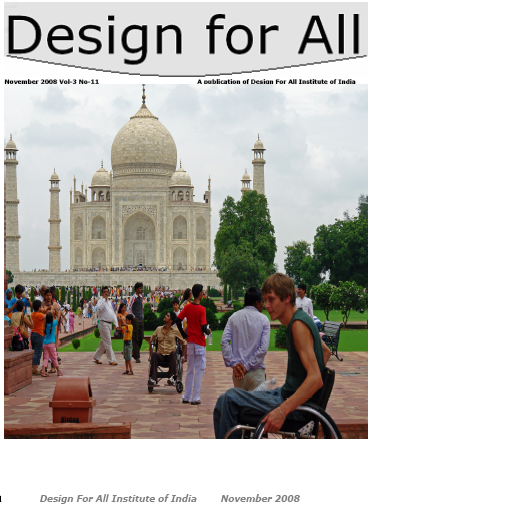 niversal
design refers to broad-spectrum ideas meant to produce buildings,
products and environments that are inherently accessible to both
people without disabilities and people with disabilities. The term
"Universal design" means
the concept of designing all products and the built environment to be
aesthetic and usable to the greatest extent possible by everyone,
regardless of their age, ability, or status in life.
niversal
design refers to broad-spectrum ideas meant to produce buildings,
products and environments that are inherently accessible to both
people without disabilities and people with disabilities. The term
"Universal design" means
the concept of designing all products and the built environment to be
aesthetic and usable to the greatest extent possible by everyone,
regardless of their age, ability, or status in life.
Universal design emerged from slightly earlier barrier-free concepts, the broader accessibility movement, and adaptive and assistive technology and also seeks to blend aesthetics into these core considerations. As life expectancy rises and modern medicine increases the survival rate of those with significant injuries, illnesses, and birth defects, there is a growing interest in universal design. There are many industries in which universal design is having strong market penetration but there are many others in which it has not yet been adopted to any great extent.
D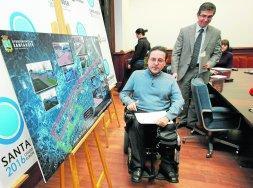 isabled
persons encounter many obstacles that prevent them from moving about
freely and safely. For wheelchair users, steps and stairways are
obstacles. Blind people are endangered by the absence of directional
and safety features that they can hear and touch. As a result of
changes in governmental policies to address the need to train persons
with disabilities to acquire skills and necessary vocations and
professions for active participation in the socio-economic
development process, there is an upsurge of the number of disabled
persons who are leading active public lives, becoming part of the
user-group utilizing public buildings for production, recreation,
commerce, transportation, education etc.
isabled
persons encounter many obstacles that prevent them from moving about
freely and safely. For wheelchair users, steps and stairways are
obstacles. Blind people are endangered by the absence of directional
and safety features that they can hear and touch. As a result of
changes in governmental policies to address the need to train persons
with disabilities to acquire skills and necessary vocations and
professions for active participation in the socio-economic
development process, there is an upsurge of the number of disabled
persons who are leading active public lives, becoming part of the
user-group utilizing public buildings for production, recreation,
commerce, transportation, education etc.
A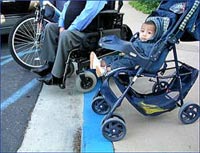 lthough
Universal Design standards address the needs of people with
disabilities, it is a comprehensive concept that can benefit all
users. For example, people who are unusually short or tall, carrying
packages or pushing a cart are not disabled, but their needs should
be considered in facility design. Increased walkway widths, low-floor
buses and smooth walking surfaces improve convenience for all
travelers, not just those with mobility impairments. Curb cuts or
sidewalk ramps are important for people using handcarts, scooters,
baby strollers and bicycles, as well as wheelchair users.
lthough
Universal Design standards address the needs of people with
disabilities, it is a comprehensive concept that can benefit all
users. For example, people who are unusually short or tall, carrying
packages or pushing a cart are not disabled, but their needs should
be considered in facility design. Increased walkway widths, low-floor
buses and smooth walking surfaces improve convenience for all
travelers, not just those with mobility impairments. Curb cuts or
sidewalk ramps are important for people using handcarts, scooters,
baby strollers and bicycles, as well as wheelchair users.

Automatic door openers are another example of Universal Design features that can benefit many types of users. There are also cabinets with pull-out shelves, kitchen counters at several heights to accommodate different tasks and postures, and, amidst many of the world's public transit systems, low-floor buses that "kneel" (bring their front end to ground level to eliminate gap) and/or are equipped with ramps rather than on-board lifts.
D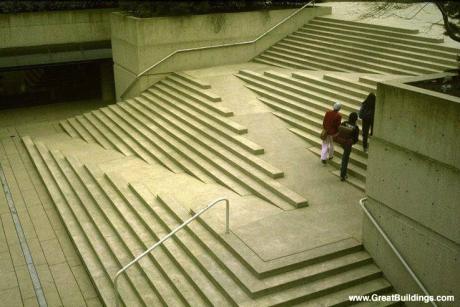 esign
For All (DfA). The term Design for All is used to describe a
design philosophy targeting the use of products, services and systems
by as many people as possible without the need for adaptation. Design
for All is design for human diversity, social inclusion and equality.
The origin of Design for All lies in the field of barrier free
accessibility for people with disabilities and the broader notion of
universal design.
esign
For All (DfA). The term Design for All is used to describe a
design philosophy targeting the use of products, services and systems
by as many people as possible without the need for adaptation. Design
for All is design for human diversity, social inclusion and equality.
The origin of Design for All lies in the field of barrier free
accessibility for people with disabilities and the broader notion of
universal design.
Design for All has become a mainstream issue because of the aging of the population and its increasingly multi-ethnic composition. It follows a market approach and can reach out to a broader market. Easy-to-use, accessible, affordable products and services improve the quality of life of all citizens. Design for All permits access to the built environment, access to services and user-friendly products which are not just a quality factor but a necessity for many aging or disabled persons.
B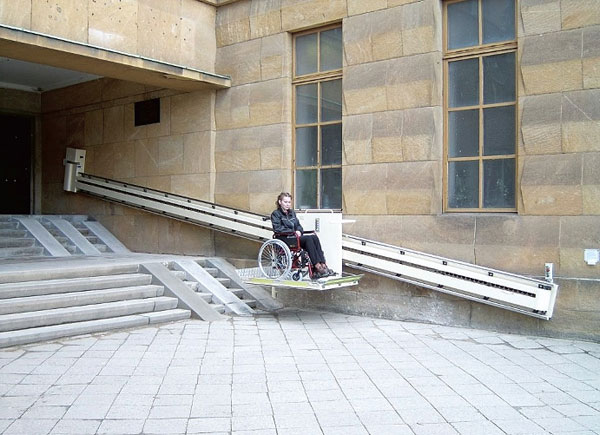 arrier-free
building modification consists of modifying buildings or
facilities so that they can be used by the physically disabled. The
term is used primarily in Japan and non-English speaking countries,
while in English-speaking countries, terms such as "accessibility"
and "handicapped accessible" dominate in regular everyday
use. An example of barrier-free design would be installing a ramp for
wheelchairs alongside or in place of steps. In
the case of new buildings, however, the idea of barrier free
modification has largely been superseded by the concept of universal
design, which seeks to design things from the outset to support easy
access.
arrier-free
building modification consists of modifying buildings or
facilities so that they can be used by the physically disabled. The
term is used primarily in Japan and non-English speaking countries,
while in English-speaking countries, terms such as "accessibility"
and "handicapped accessible" dominate in regular everyday
use. An example of barrier-free design would be installing a ramp for
wheelchairs alongside or in place of steps. In
the case of new buildings, however, the idea of barrier free
modification has largely been superseded by the concept of universal
design, which seeks to design things from the outset to support easy
access.
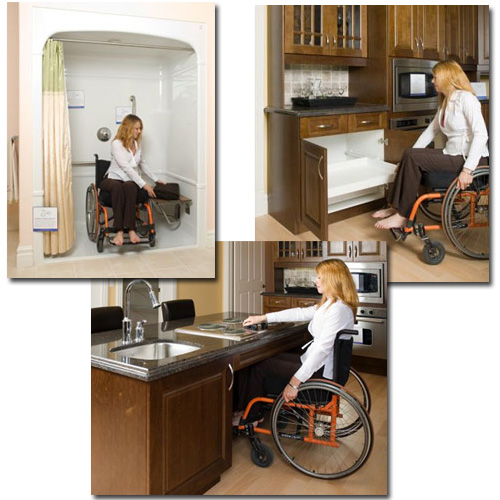
"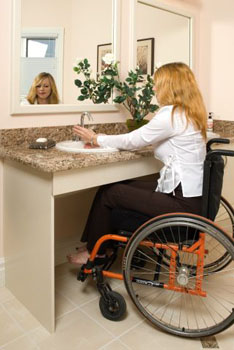 Quality's
model Graystone estate home is outfitted with an extensive range of
barrier-free features, including wider doorways, lowered thresholds,
lowered and two-tiered counters, overhead cupboards with a motorized
mechanism which lowers them, wheel-in stove, built-in wall oven and
microwave, grab bars, wheel-in shower, raised sink and tub, lower
light switches and more."
Quality's
model Graystone estate home is outfitted with an extensive range of
barrier-free features, including wider doorways, lowered thresholds,
lowered and two-tiered counters, overhead cupboards with a motorized
mechanism which lowers them, wheel-in stove, built-in wall oven and
microwave, grab bars, wheel-in shower, raised sink and tub, lower
light switches and more."
Freeing a building of barriers means:
Smooth, ground level, entrances without stairs
Surface that are stable, firm and slip resistant
Wide interior doors, hallways, and alcoves
Functional clearances to approach and use elements and components
Lever handles for opening doors rather than twisting knobs
Components that do not require tight grasping, pinching or twisting of the wrist
B
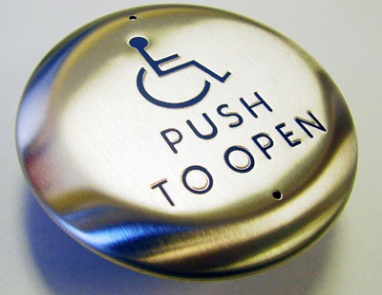 uttons
and other controls that can be distinguished by touch
uttons
and other controls that can be distinguished by touchBright and appropriate lighting
Auditory output redundant with information on visual displays
Visual output redundant with information in auditory output
Use of meaningful icons with text labels
Choice of language on speech output
Ramp access in swimming pools
Labels on equipment control buttons that is large print
A museum that allows visitors to chose to listen to or read descriptions
Barrier-free town. Led by the guiding principle that a “town easy to live in is one easy to visit,” the City of Takayama (Japan) is working on a barrier-free, town-making program to turn itself into a tourist community where both physically handicapped people and the elderly can live a safe, comfortable life. The city is also probing the possibilities of making “information barrier-free” to expedite the flow of communication to promote deeper mutual understanding between visitors and local community residents in the current context of growing worldwide tourism.
Constructing bump-free streets
Bump-free streets are being constructed and crossings modified to enable the safe passage of people in wheelchairs.
